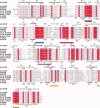The structure of a putative S-formylglutathione hydrolase from Agrobacterium tumefaciens
- PMID: 19653299
- PMCID: PMC2786982
- DOI: 10.1002/pro.216
The structure of a putative S-formylglutathione hydrolase from Agrobacterium tumefaciens
Abstract
The structure of the Atu1476 protein from Agrobacterium tumefaciens was determined at 2 A resolution. The crystal structure and biochemical characterization of this enzyme support the conclusion that this protein is an S-formylglutathione hydrolase (AtuSFGH). The three-dimensional structure of AtuSFGH contains the alpha/beta hydrolase fold topology and exists as a homo-dimer. Contacts between the two monomers in the dimer are formed both by hydrogen bonds and salt bridges. Biochemical characterization reveals that AtuSFGH hydrolyzes C--O bonds with high affinity toward short to medium chain esters, unlike the other known SFGHs which have greater affinity toward shorter chained esters. A potential role for Cys54 in regulation of enzyme activity through S-glutathionylation is also proposed.
Figures


References
-
- Uotila L, Koivusal M. Purification and properties of S-formylglutathione hydrolase from human liver. J Biol Chem. 1974;249:7664–7672. - PubMed
-
- Haslam R, Rust S, Pallett K, Cole D, Coleman J. Cloning and characterisation of S-formylglutathione hydrolase from Arabidopsis thaliana: a pathway for formaldehyde detoxification. Plant Physiol Biochem. 2002;40:281–288.
-
- Kordic S, Cummins I, Edwards R. Cloning and characterization of an S-formylglutathione hydrolase from Arabidopsis thaliana. Arch Biochem Biophys. 2002;399:232–238. - PubMed
Publication types
MeSH terms
Substances
Grants and funding
LinkOut - more resources
Full Text Sources

